PDF chapter test TRY NOW
Phylum: Annelida: E.g., Earthworm
Annelid nervous systems are similar in basic form to flatworm nervous systems, although they are more centralised and include longitudinal nerve connections. A nerve ring and a solid, double, midventral nerve cord with ganglia make up the neurological system of Annelida.

The earthworm's nervous system, like the rest of its anatomy, is "segmented." The "brain" is connected to the first ventral ganglion and is located above the pharynx. The brain is necessary for movement: if the earthworm's brain is removed, it will continue to move. If the first ventral ganglion is damaged, the earthworm will stop eating and will not dig. Each segmented ganglion receives sensory information from only a local area of the body and controls only the muscles in that region. Touch, light, vibration, and chemical receptors cover the whole-body surface of earthworms.
Phylum: Arthropod: E.g., Grasshopper
The nervous system of arthropods is similar to that of annelids. A nerve ring and a double ganglionated ventral nerve cord make up the nervous system of arthropods.
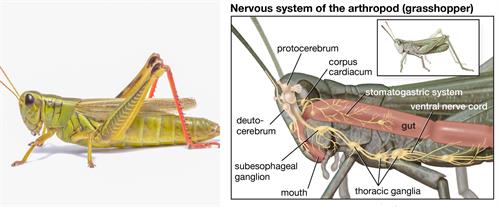
The grasshopper's brain is positioned directly above the oesophagus, between its eyes. A pair of ventral nerves that encircle the gut connects the brain to the 1st ventral ganglion. Without its brain, the grasshopper can move and jump, among other things. The brain helps with movement by relaying sensory information to other regions of the body. The first ventral ganglion is primarily responsible for controlling mouth movement. A double nerve cord connects the segmental ganglia throughout the length of the grasshopper to the first ventral ganglion, which serves to coordinate local activity.
Insects have a compound eye that is made up of several separate "ommatidia" units. Each ommatidia functions as a little lens, sampling a small portion of the visual field. A single insect eye might include thousands of ommatidia.
Important!
Science fiction movies depicting an insect seeing hundreds of similar images of the full visual field are incorrect; an insect sees only one image at a time because each ommatidium only views a small part of the total field.
Some insects are sensitive to ultraviolet light, whereas others can detect light in the infrared spectrum.
Phylum: Mollusca: E.g., Octopus
The nervous system comprises pairs of cerebral, plural, pedal, and visceral ganglia connected by nerve connectives and commissures.
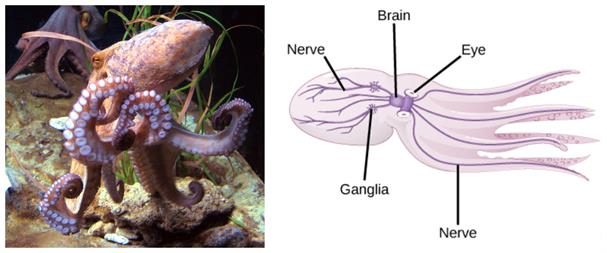
Structure and nervous system of octopus
Of all the invertebrates, the octopus has the most complex brain. The neurological system contains around \(500,000,000\) neurons, with two-thirds of these neurons located in the octopus' arms. The lobes and tracts of neurons in the octopus's brain is more specialised than simple ganglia. An octopus has a "good" memory to learn.
The cornea, lens, iris, and retina of an octopus eye are very similar to vertebrates. It's also capable of focusing and forming images. On the other hand, the octopus eye differs from vertebrate eyes. It focuses light by shifting the lens closer and farther away from the retina. The lens of the vertebrate eye changes its shape to focus. An octopus can detect the shape, colour intensity, and texture.
Another distinction is that the octopus's eye has no blind spot since the nerve cells leave the eyeball from the outside. In addition to the brain, the octopus contains a statocyst. The statocyst detects and responds to changes in gravity and acceleration.
Phylum: Echinodermata: E.g., Starfish
The nervous system of the Echinodermata is not centralised, and there are no cerebral ganglia. There are three major neural networks in the body. A nerve ring surrounds each network, with radial branches leading to the disc and arms. An epidermal nerve net connects the networks.
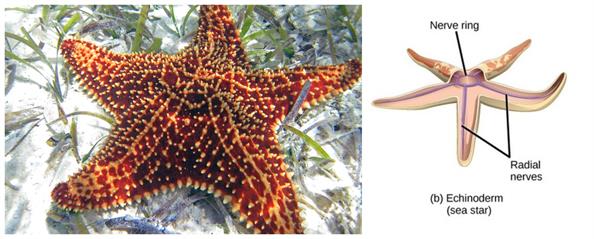
Structure and nervous system of starfish
The starfish's nervous system is incredibly simple. There is no brain, and there are no ganglia to help in movement coordination. A nerve ring that surrounds the mouth is part of the nervous system. Each arm is served by a radial nerve that branches from the nerve ring. The way starfish detect light is amazing. At the end of each arm, they have "eyespots." Light-sensitive pigments in the eyespot enable the starfish to sense shadows and variations in light brightness.
Phylum: Hemichordate: E.g., Balanoglossus
The central nervous system of hemichordates is similar to that of non-chordates. A ring of nerves represents the brain.
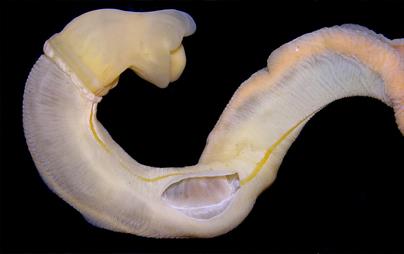
Structure of Balanoglossus
Balanoglossus has a primitive neural system that resembles that of coelenterates and echinoderms. The nervous layer thickens along definite strands to form 2 main nerve cords that run the length of the trunk, one mid-dorsal and the other mid-ventral.
Phylum: Chordata: E.g., Fish
The central nervous system of chordates is made up of a hollow nerve tube that runs along the length of the animal, dorsal to the notochord.
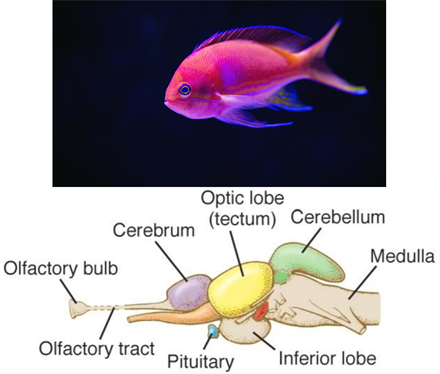
Nervous system of fish
Fish have complex nerve systems that are arranged around the brain. The brains of fish have various sections that are easily visible. The olfactory bulbs are the most anterior parts of a fish's brain. Stalks connect them to the two lobes of the cerebrum.
Vertebrate nervous system
Fish, amphibians, reptiles, birds, and mammals are the five vertebrate classes. The nervous system of vertebrates is divided into three components.
- The central nervous system and the peripheral nervous system (brain and spinal cord)
- The nervous system of the periphery (cranial and spinal nerves)
- System of autonomic nerves (sympathetic and parasympathetic nervous systems)
Reference:
https://pixabay.com/photos/worm-earthworm-annelid-belt-worm-4763219/
https://www.britannica.com/science/nervous-system/Annelids
https://www.britannica.com/science/nervous-system/Arthropods
https://commons.wikimedia.org/wiki/File:Figure_35_01_01.jpg
https://commons.wikimedia.org/wiki/File:Octopus_vulgaris_BCN_0219_Mustekala_C.JPG
https://www.flickr.com/photos/jsjgeology/16119005186
https://www.flickr.com/photos/artour_a/257938137
https://nstuocn.files.wordpress.com/2018/09/nervous-system1.pdf
https://cdn1.photostockeditor.com/h/1604/animal-close-up-photography-of-red-fish-fish-fish-image.jpg
